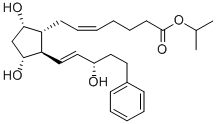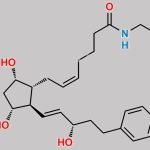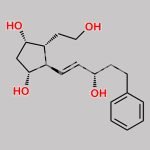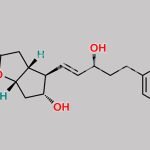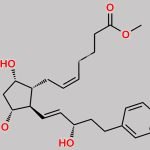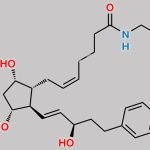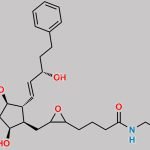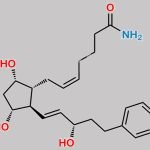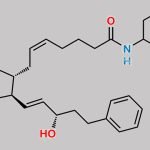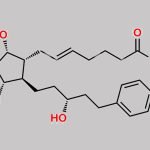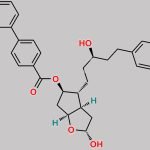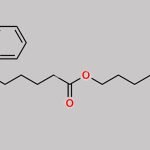Bimatoprost isopropyl ester CAS#: 130209-76-6; ChemWhat Code: 416872
Identification
| Patent Information | ||
| Patent ID | Title | Publication Date |
| US2016/106651 | COMPOSITIONS AND METHODS FOR TREATING HAIR LOSS USING NON-NATURALLY OCCURRING PROSTAGLANDINS | 2016 |
| WO2009/35565 | PROSTAGLANDIN ANALOGUES FOR IMPLANT DEVICES AND METHODS | 2009 |
| US2009/259058 | Process for the Preparation of Prostaglandin Analogues and Intermediates Thereof | 2009 |
Physical Data
| Appearance | Pale yellow to colorless oily liquid or pale yellow to white waxy solid |
Spectra
| Description (NMR Spectroscopy) | Nucleus (NMR Spectroscopy) | Solvents (NMR Spectroscopy) |
| Chemical shifts | 1H | CDCl3 |
| Chemical shifts | 13C | CDCl3 |
Route of Synthesis (ROS)
| Conditions | Yield |
| In methanol at 80℃; for 24 – 48h; Experimental Procedure Example 4. Preparation of 17-phenyl trinor PGF2α isobutyl amide from ester A solution of 17-phenyl- 13,14-dihydro trinor PGF2α isopropyl ester (43.3 mg, 0.1 mmol.) and isobutylamine (1.0 mL, 10.1 mmol.) in MeOH (4.0 mL) is heated to 80 0C for 24-48 hours. The reaction is cooled to room temperature and concentrated in vacuo. The residue was purified by flash chromatography on silica gel, using CH2Cl2ZMeOH as eluent to afford 17-phenyl trinor PGF2α isobutyl amide (> 80% yield). | 80% |
Safety and Hazards
| Pictogram(s) |   |
| Signal | Danger |
| GHS Hazard Statements | H302+H312+H332 (100%): Harmful if swallowed, in contact with skin or if inhaled [Warning Acute toxicity, oral; acute toxicity, dermal; acute toxicity, inhalation] H302 (100%): Harmful if swallowed [Warning Acute toxicity, oral] H312 (100%): Harmful in contact with skin [Warning Acute toxicity, dermal] H332 (100%): Harmful if inhaled [Warning Acute toxicity, inhalation] H360 (100%): May damage fertility or the unborn child [Danger Reproductive toxicity] |
| Precautionary Statement Codes | P203, P261, P264, P270, P271, P280, P301+P317, P302+P352, P304+P340, P317, P318, P321, P330, P362+P364, P405, and P501 (The corresponding statement to each P-code can be found at the GHS Classification page.) |
Other Data
| HS Code | |
| Storage | Store -10°C for long time, in container tightly sealed; Protect from light and moisture. |
| Shelf Life | 2 year |
| Market Price |
| Druglikeness | |
| Lipinski rules component | |
| Molecular Weight | 430.585 |
| logP | 4.145 |
| HBA | 5 |
| HBD | 3 |
| Matching Lipinski Rules | 4 |
| Veber rules component | |
| Polar Surface Area (PSA) | 86.99 |
| Rotatable Bond (RotB) | 13 |
| Matching Veber Rules | 1 |
| Use Pattern |
| Bimatoprost is widely used in the cosmetic field to promote eyelash growth. Its mechanism of action and effects are as follows: Mechanism of Action Bimatoprost prolongs the growth phase of eyelashes (the active phase in the eyelash growth cycle) and increases the number of hair follicles, stimulating natural eyelash growth. This mechanism significantly enhances eyelash density, length, and pigmentation. Application Method It is typically applied topically using a special applicator to place the solution at the base of the upper eyelashes (avoiding contact with the eyes and lower lashes). A common recommendation is to apply it once daily. Effectiveness Bimatoprost use generally starts to show results after 4–8 weeks, with optimal effects observed at 12–16 weeks. Eyelashes become noticeably longer, denser, and darker due to increased pigmentation, giving them a more prominent and defined appearance. |
Related Chemicals
Buy Reagent | |
| No reagent supplier? | Send quick inquiry to ChemWhat |
| Want to be listed here as a reagent supplier? (Paid service) | Click here to contact ChemWhat |
Approved Manufacturers | |
| Want to be listed as an approved manufacturer (Requires approvement)? | Please download and fill out this form and send back to approved-manufacturers@chemwhat.com |
Contact Us for Other Help | |
| Contact us for other information or services | Click here to contact ChemWhat |

